Nagamachi & Teramachi Area
A “Corridor of Everyday Culture” in Nagamachi & Teramachi that distills the daily life of the Kaga Domain.
From Nagamachi with its samurai mud walls and waterways, to the museum that recreates an actual ashigaru (foot soldier) home, the nostalgic Nishi Chaya District, the trick-filled Myōryūji (Ninja Temple), and prayer/ancestral temples tied to the Maeda family—this area brings them all together. You’ll even find the refined garden beauty of the Nomura Family Garden and Sendake Garden. Here, samurai life × defensive urban design × faith & performing arts overlap in vivid, three-dimensional ways.
On this page, you can tour each spot with 360° photos while getting compact explanations of architectural and streetscape highlights, historical context, travel time, and access. Before you walk, you’ll grasp the city’s structure and backstory—and on-site, the details will pop even more.
Map: Nagamachi & Teramachi Area
Hōchizan Kudoku-in Dairenji (寶池山 功徳院 大蓮寺)
⭐ Recommendation
Historical Value: ☆☆☆
Visual Appeal: ☆☆
Experiential Value: ☆☆
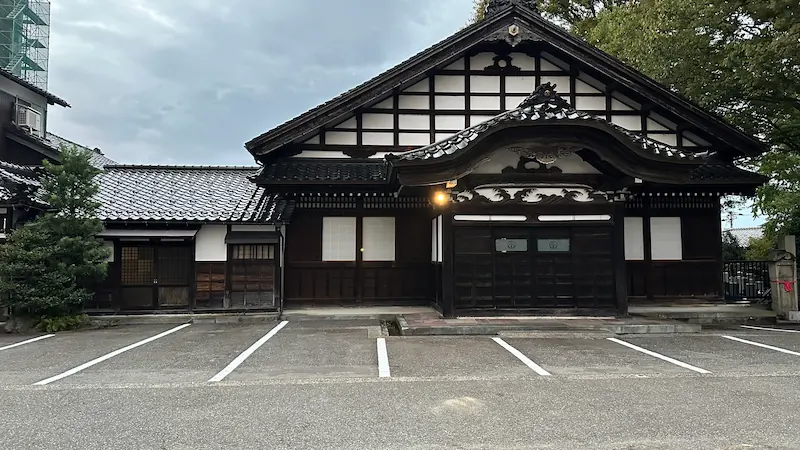
Dairenji is a Jōdo-shū (Pure Land) temple in Nomachi, Kanazawa. Its formal name is **Hōchizan Kudoku-in Dairenji**. It was founded in 1604 (Keichō 9) by Koizuka Hidemasa (Koizuka Awaji-no-kami Hidemasa), a senior retainer of Maeda Toshiie, the Kaga Domain’s founder. The mountain name “Hōchizan” (“Treasure Pond Mountain”) is said to come from the site’s lower elevation than the road—likened to a “pond” filled with the treasure-like teachings of Amida. Records suggest the temple originally stood inside or near the castle grounds, then received a replacement site in Nomachi and moved to its current location.
| Founded | 1604 (Keichō 9) |
|---|---|
| Founder/Patron | Koizuka Awaji-no-kami Hidemasa (Koizuka Hidemasa) |
| Sect / Sango / Ingo | Jōdo-shū / Hōchizan Kudoku-in |
| Formal Name | Hōchizan Kudoku-in Dairenji |
| Existing Structures | Main hall (reconstructed in 1815, Bunka 12), West Main Gate, memorial towers, etc. |
| Cultural Property Status | No specific designation recorded |
| Notes | Known as a memorial/ancestral temple for Lady Gō (Toshiie’s 4th daughter; wife of Ukita Hideie) |
🗺 Address: 2-1-14 Nomachi, Kanazawa, Ishikawa
🚶 Access
Bus: 2 min on foot from “Hirokōji” stop on the Kanazawa Loop Bus / Hokutetsu local bus, or 1 min on foot from “Nishi Chaya District.”
⏳ Visiting Time
Strolling the grounds: about 5 minutes
Including an interior visit: about 15 minutes (reservation required)
📍 Highlights
- Connection to Lady Gō: A memorial/ancestral temple for Lady Gō (Toshiie’s 4th daughter and wife of Ukita Hideie), enshrining her mortuary tablet and personal Buddhist image (a Sacred Kannon).
- Memorial towers for Lady Gō & Ukita Hideie: Side-by-side memorial towers for the couple stand within the precincts.
- West Main Gate relief of Lady Gō: A relief of Lady Gō was installed at the West Main Gate in 1994, followed by memorial services for her 360th anniversary the next year.
- Graves of notable locals: Tombs related to the tea merchant “Dōgoya,” Neo-Confucian scholar Fujita Koremasa, and other affiliates are dotted around the grounds.
- Precinct scenery & Enmei Jizō: Jizō statues—including one dedicated to longevity—reflect the temple’s deep ties with Jizō devotion.
📌 Trivia
- Main hall reconstruction & Maeda support: The current main hall was rebuilt in 1815 (Bunka 12). At that time, the 15th head priest, Nyūyo Shōnin, is said to have received a donation of fifty pines from the Maeda family.
- Name inspired by the terrain: With the temple grounds lying lower than the street, the site was likened to a “pond,” hence the mountain name “Hōchizan” (“Treasure Pond”).
- Relocation from its original site: Records note it was first built near the castle (around today’s Kinoshimbō/Kakinokibatake), then moved to Nomachi when the original site became official land.
- Lady Gō’s fate & memorialization: After Ukita Hideie was exiled following the Battle of Sekigahara, Lady Gō returned to Kanazawa. Dairenji became a place to honor their bond. In 1995 (her 360th anniversary), their hair (not bones) was apportioned here for joint memorial enshrinement.
Nishi Chaya District (にし茶屋街)
⭐ Recommendation
Historical Value: ☆☆☆
Visual Appeal: ☆☆☆
Experiential Value: ☆☆
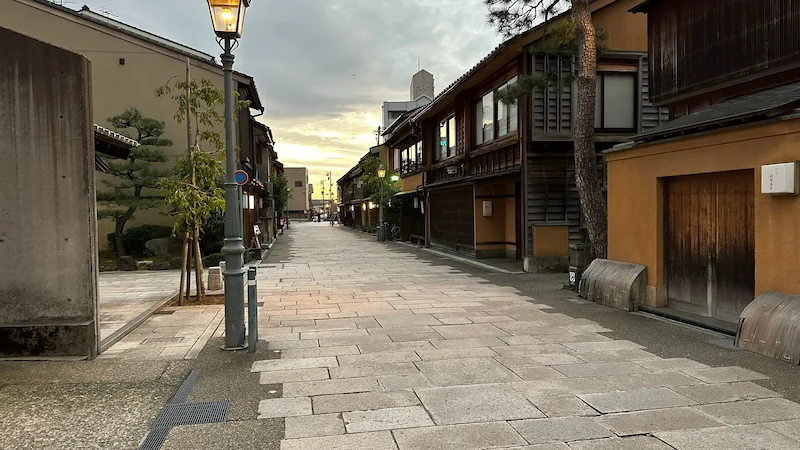
Nishi Chaya District is one of Kanazawa’s three chaya (teahouse/entertainment) quarters—along with Higashi Chaya and Kazue-machi. It is said to have been officially licensed by the Kaga Domain in 1820 (Bunsei 3). The street is compact—about 100 meters long—but retains traditional two-story chaya buildings with lattice facades and a calm, refined atmosphere. Today there are five active teahouses (Meigetsu, Mion, Hankei, Asano-ya, and Hana-no-Yado) with around 15 geiko in total—the largest number among the three districts.
Panorama
| Established | 1820 (Bunsei 3), officially licensed |
|---|---|
| Name Origin / Layout | Called “Nishi (West) Chaya” as the entertainment quarter west of the castle |
| Architectural Features | Two-story wooden chaya houses with latticework facades |
| Key Sites | Nishi Chaya Shiryōkan (Museum; former Yoshikome-rō site), Nishi Kenban Office (Registered Tangible Cultural Property) |
| Number of Geiko | Several active teahouses keep the geiko tradition alive |
| Current Condition | Well preserved; the townscape retains its historic character |
| Notes | Generally quieter than other districts—ideal for an unhurried stroll |
🗺 Address: Nomachi 2-chōme, Kanazawa, Ishikawa (Nishi Chaya District)
🚶 Access
About 3 minutes on foot (250 m) from Hōchizan Kudoku-in Dairenji
⏳ Visiting Time
Street stroll: 10–20 minutes
Including museum/teahouse interiors: about 40 minutes
📍 Highlights
- Nishi Chaya Museum (former Yoshikome-rō): Built on the site of Yoshikome-rō, a teahouse frequented by Taishō-era writer Shimada Seijirō; the interior recreates a traditional chaya.
- Nishi Kenban Office: An early 20th-century office with a Western-style facade; a Registered Tangible Cultural Property.
- Chaya streetscape: A row of charming machiya with lattices and two-story structures.
- Geiko culture: After dusk you may hear shamisen and drums—the district’s atmosphere truly comes alive.
- Sweet-tooth heaven: Recently, cafés and wagashi shops have flourished—perfect for pairing treats with your stroll.
📌 Trivia
- Also called “Nishi no Kuruwa”: At its founding, the area was known as the “Western Enclosure,” reflecting how entertainment quarters were set apart from everyday society.
- Most geiko among the three quarters: As noted, it currently hosts the largest number of geiko in Kanazawa’s three chaya districts.
- Close to the Ninja Temple: Myōryūji (Ninja Temple) is within easy walking distance, making it simple to combine the two.
- Quieter vibes: Compared to Higashi Chaya, visitor traffic is lighter, allowing for a more relaxed visit.
Shokyūzan Myōryūji / “Ninja Temple”
⭐ Recommendation
Historical Value: ☆☆☆
Visual Appeal: ☆☆☆
Experiential Value: ☆☆☆
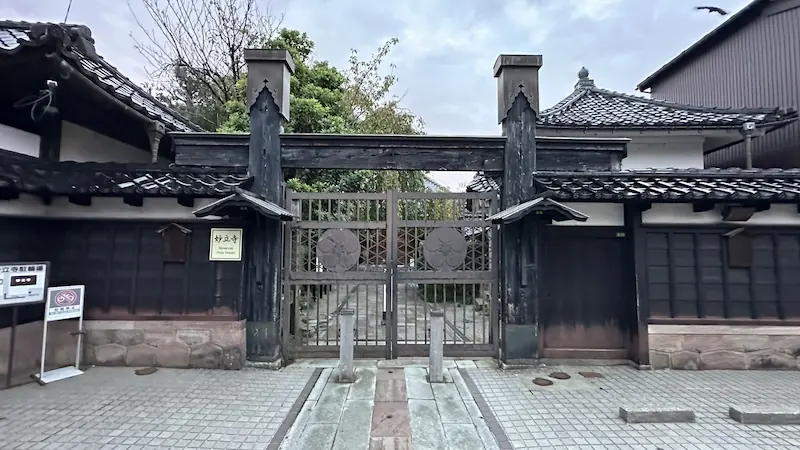
A must on any Kanazawa trip, Shokyūzan Myōryūji—nicknamed the “Ninja Temple.” Despite the name, real ninja weren’t involved; instead, under the shogunate’s watchful eye, the Kaga Domain designed this temple as a “trick temple” to mislead enemies in an emergency. A Nichiren temple, it developed into its present form after the domain’s 3rd lord, Maeda Toshitsune, relocated a former castle-prayer hall here.
| Founded / Relocated | Founded 1643 (Kan’ei 20); relocated to Teramachi-dai in 1659 (current site) |
|---|---|
| Sect / Sango | Nichiren-shū / Shokyūzan |
| Structure & Features | Looks like two stories from outside, but hides seven internal levels, 23 rooms, and 29 stairways. Packed with tricks—trapdoors, hidden stairs, shifting floors, and a lookout tower. |
| Role / Function | Served as a prayer temple for the Kaga lords and likely functioned as a defensive outpost within the Teramachi temple belt. |
| Visiting Rules | Advance reservation required; guided tours only. No photos or recordings inside. |
| Hours / Admission | Usually 9:00–16:00 (to 16:30 from Mar–Oct); closed New Year and memorial days. Fee: Adults ¥1,200 / Elementary school ¥800 (discounts/changes possible) |
| Address | 1-2-12 Nomachi, Kanazawa, Ishikawa |
| Notes | Uses the Maeda family crest “Ken-umebachi” as the temple crest. |
🗺 Access
About 4 minutes on foot (240 m) from Nishi Chaya District
⏳ Time Required
Quick highlights: about 30 minutes
Leisurely visit: about 40 minutes
🌎 Official Website
📍 Highlights
- Offering box that becomes a trap: Legend says removing the offering box triggers a drop floor.
- Hidden stairs & shifting floors: Lift a floorboard to reveal a secret stair—or find routes that change as floors move.
- Lookout tower: A watch platform on the main hall roof supposedly offered long-distance views.
- Escape well: A well in the basement is said to have connected to an escape route towards Kanazawa Castle.
- Complex vertical plan: Though it looks like two stories, the building conceals seven levels, 23 rooms, and 29 stairways.
- Low tea-room ceiling: Some tea rooms have intentionally low ceilings to limit an intruder’s movement.
- Ken-umebachi crest: The Maeda family crest appears in temple ornamentation, underscoring the Kaga connection.
📌 Trivia
- Why “Ninja Temple”?: The nickname comes from its ninja-house-like tricks—not from any actual ninja affiliation.
- Temple belt as defense: The Teramachi temple belt likely doubled as a defensive network—functioning like “satellite forts” for the castle town.
- Hidden worship space: Tradition says the main hall included a concealed gallery or mezzanine so the lord could worship unnoticed among common visitors.
Senjuin (千手院)
⭐ Recommendation
Historical Value: ☆☆☆
Visual Appeal: ☆☆
Experiential Value: ☆
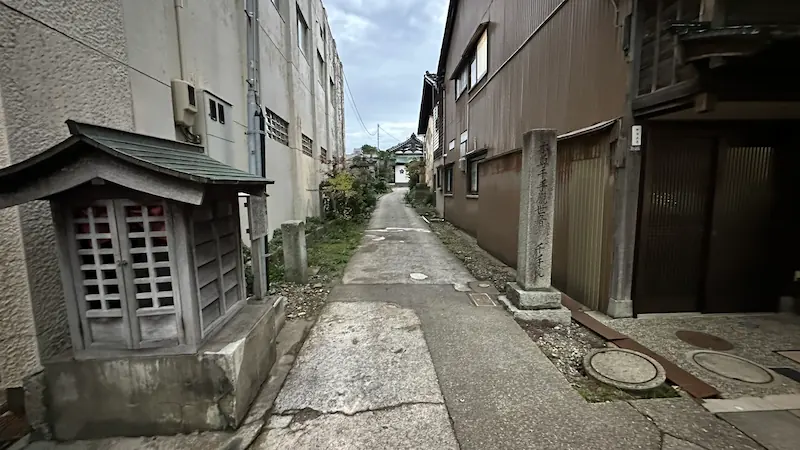
Senjuin belongs to the Kōyasan Shingon-shū and is part of Kanazawa’s Teramachi temple district. It served as a kigan-sho (prayer temple) long cherished by the Maeda lords. Tradition says the first lord, Maeda Toshiie, prayed here for victory at the Battle of Suemori in Noto. Thereafter, the temple was positioned as a prayer site for the ruling family. Within the grounds you’ll find statues such as the Eleven-faced Kannon reputedly entrusted by the Maeda, groups of stone Buddhas, and Jizō along the approach—quiet yet steeped in history.
| Sect / Sango | Kōyasan Shingon-shū / Chōkyūzan Senjuin |
|---|---|
| Location | 3-1-26 Nomachi, Kanazawa, Ishikawa |
| Main Image / Treasures | Senju Kannon (Thousand-armed Kannon); Eleven-faced Kannon (traditionally from the Maeda family); Jizō and stone Buddhas; sutra tube |
| Origins / Moves | Tradition: founded in Tenchō era (824–834) at Tsurugi → moved to Kenrokuzaka → relocated to Teramachi in the Genna era |
| Role / Character | Prayer temple of the Kaga lords; closely tied to the Maeda family |
| Visiting | Grounds and interior generally open; no admission fee |
| Notes | Some sources note that goshuin (seal stamps) are generally not issued |
🗺 Address: 3-1-26 Nomachi, Kanazawa, Ishikawa
🚶 Access
About 6 minutes on foot (450 m) north from Myōryūji
⏳ Time Needed
Grounds: about 15–20 minutes
For statues/interior in detail: around 30 minutes
📍 Highlights
- Eleven-faced Kannon: A statue traditionally said to have been entrusted by the Maeda family—a symbol of the temple’s lineage.
- Jizō & stone Buddhas along the path: A welcoming, devotional atmosphere as you approach the hall.
- Sutra tube & treasures: Records mention a sutra cylinder holding prayer documents from the Maeda; intricate carvings of cranes, turtles, and pine-bamboo-plum motifs.
- Main hall with plum-blossom crest: The Maeda “umebachi” crest can be found on the exterior, according to tradition.
- Historic lore: Tradition holds that Toshiie prayed here before the Suemori campaign—after which it became a regular prayer site for the lords.
📌 Trivia
- Layered founding stories: Multiple relocations and restorations over centuries have left overlapping traditions about its original site and moves.
- Prayer temple status: Its reputation stems from Toshiie’s victory prayers, later formalized as a lords’ prayer site.
- No admission fee: Grounds and buildings are generally free to visit (always confirm on site).
- No goshuin in principle: Some guides note that temple seals are not regularly offered.
Gesshōji (月照寺)
⭐ Recommendation
Historical Value: ☆☆☆
Visual Appeal: ☆☆
Experiential Value: ☆☆
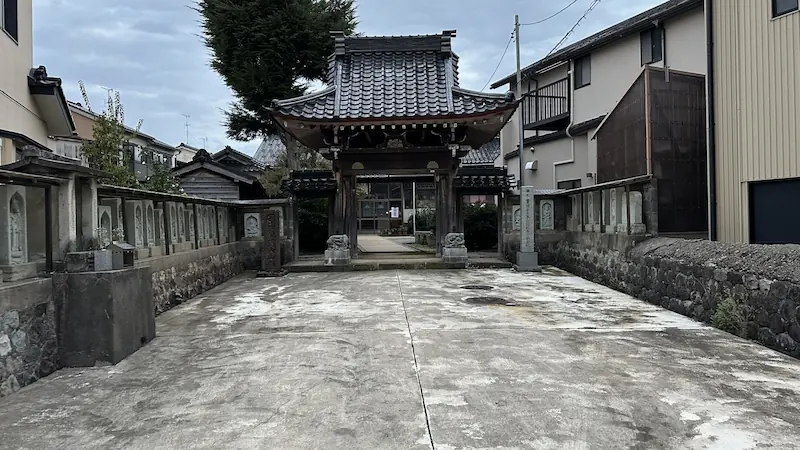
Gesshōji is the family temple of Shunkei-in (Princess Sachi), the eldest daughter of Maeda Toshiie and Matsu. The precinct was expanded during the time of the 3rd lord, Maeda Toshitsune, and once held large halls before they were lost in the “Rokuto Fire.” The present buildings were rebuilt using parts of Maeda residences. A striking cluster of stone Buddhas stands in the grounds—said to be gathered statues of Kannon once located on Mt. Utatsu and along the Tsurugi road.
| Founded | 1652 (Keian 5) |
|---|---|
| Founder | Maeda Nagatoshi (son of Princess Sachi) |
| First Abbot | Eigaku Oshō (5th abbot of Ryūenji) |
| Sect | Sōtō Zen (Tōkōzan Gesshōji) |
| Structure / Features | Main hall, gate, and kura storehouses (many reconstructed/relocated parts); cluster of stone Buddhas |
| Fires & Changes | Burned in a major fire; rebuilt/relocated in the Meiji era |
| Current State | Buildings remain; interior visits by reservation/limited |
| Cultural Status | No special designation noted |
| Notes | Houses two sets of 33 Kannon images said to come from Mt. Utatsu and the Tsurugi road; grounds free to enter |
🗺 Address: 3-20-34 Nomachi, Kanazawa, Ishikawa
🚶 Access
About 3 minutes on foot from Hokutetsu Bus “Numata-machi.”
⏳ Time Needed
Grounds: about 15–20 minutes
Including interior: about 30–45 minutes (reservation required)
📍 Highlights
- Cluster of stone Buddhas: Tradition says 33 Kannon from Mt. Utatsu and another 33 from the Tsurugi road were gathered here.
- Temple gate: Retains elements of older architecture—survivals from past fires.
- Rebuilt main hall: Reconstructed using parts of former Maeda residences—dignified and serene.
- Ties to Princess Sachi (Shunkei-in): Family temple for Toshiie and Matsu’s daughter; deep Maeda lineage.
- Access policy: Grounds are free; interior visits generally by reservation to protect the buildings.
Nagamachi Samurai District (長町武家屋敷跡)
⭐ Recommendation
Historical Value: ☆☆☆
Visual Appeal: ☆☆☆
Experiential Value: ☆☆
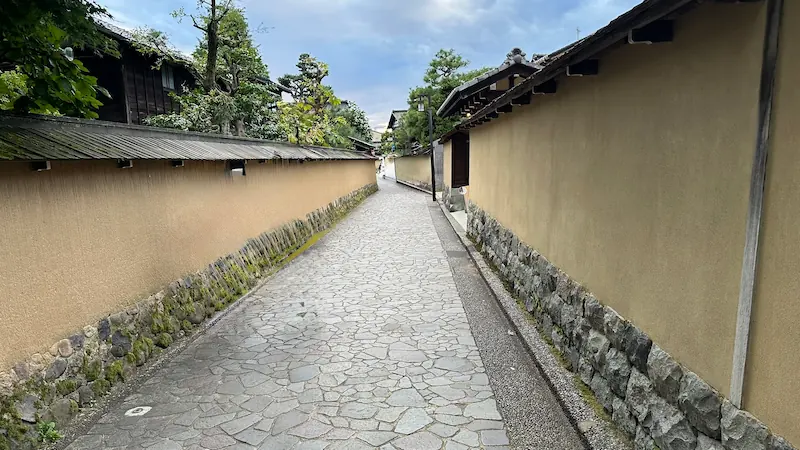
The Nagamachi Samurai District preserves the residential quarter where upper- and mid-ranking samurai lived in the Kaga era. Stone-paved lanes, ocher earthen walls, and the murmur of the Ōno-shō waterway evoke the Edo-period castle town. Just a short walk from bustling Kōrinbō/Katamachi near Kanazawa Station, step inside and the city’s tempo softens. As you stroll, you’ll intuitively grasp house layouts, lot planning, and defensive street design (including dogleg “crank” alleys) from the samurai age.
Panorama
| Period | Edo period, under the Maeda lords |
|---|---|
| Primary Use | Residential quarter for Kaga retainers (upper/middle ranks) |
| Features | Earthen walls, stone-paved alleys, narrow dogleg lanes, nagaya gates, houses with gardens |
| Preservation | Lanes and walls are well preserved; some houses (e.g., Nomura Residence) open interiors |
| Designation | Traditional environment preservation zone / scenic district |
| Notes | Nearby: Ashigaru Museum (relocated houses), Kanazawa Shinise Memorial Hall, Yuzen Museum, etc. |
🗺 Address: Nagamachi, Kanazawa, Ishikawa
🚶 Access
About 18 minutes by Hokutetsu bus from Kanazawa Station (to Kōrinbō)
⏳ Time Needed
Quick look: about 10 minutes
Leisurely stroll: about 20 minutes
📍 Highlights
- Nomura Samurai Residence: The only house in the area open to the public—don’t miss the garden, shoin architecture, old trees, lanterns, and winding stream.
- Stone lanes & earthen walls: Narrow dogleg alleys and earthen walls reflect defensive town planning.
- Ōno-shō waterway vistas: Water running right in front of residences—the interplay of water and earthen walls is classic Kanazawa.
- Ashigaru Museum: A relocated/reconstructed foot soldier’s house showing everyday life.
- Kanazawa Shinise Memorial Hall: A former merchant house (Nakaya Pharmacy) with period interiors and exhibits.
- Winter “komo-kake”: Straw mats on walls protect them from frost and snow—creating a uniquely wintry scene.
📌 Trivia
- “Goppo-ishi” stepping stones: Large stones at eaves were used to knock snow off clogs—an old Nagamachi custom.
- Name origins: The name “Nagamachi” may refer to either a retainer family named Naga who resided here, or simply its “long” townscape.
- Defensive street layout: Dogleg bends block lines of sight and slow intruders—a classic castle-town tactic.
- Michelin mention: The Nomura garden has been awarded two stars in the Michelin Green Guide Japan.
Maeda Tosanokami-ke Shiryōkan (Maeda Family Museum)
⭐ Recommendation
Historical Value: ☆
Visual Appeal: ☆☆☆
Experiential Value: ☆☆
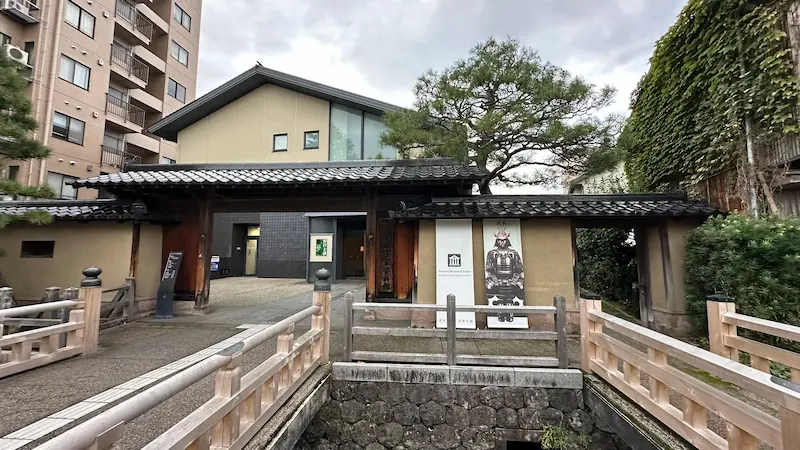
This city-run museum preserves and displays materials from the distinguished Maeda Tosanokami line—one of the “Kaga Eight” senior houses, tracing its lineage to Maeda Toshiie’s second son, Maeda Toshimasa. The exhibits bring samurai culture to life from the perspective of a leading retainer family, revealing facets of governance, domestic life, letters, and furnishings that the main Maeda house alone can’t fully show.
| Opened | April 27, 2002 |
|---|---|
| Administration | Kanazawa City / Operated by Kanazawa Cultural Promotion Foundation |
| Floor Area | Approx. 1,098 m² |
| Holdings | About 9,000 items (including Ishikawa-designated cultural properties) |
| Main Exhibits | Documents/letters, paintings/calligraphy, furnishings, arms/armor, inheritance records |
| Admission | Adults ¥310; Groups (20+) ¥260; Seniors/Persons with disabilities ¥210; High school & under free |
| Hours | 9:30–17:00 (last entry 16:30) |
| Closed | Mondays (next weekday if Monday is a holiday), year-end/New Year, exhibit changeover |
| Address | 2-10-17 Katamachi, Kanazawa |
| Access | About 5 minutes on foot from “Kōrinbō” bus stop; right by the “Shinise Memorial Hall” stop of the Kanazawa Flat Bus |
| Suggested Time | About 30 minutes (45–60 minutes if reading exhibits in depth) |
| Notes | Combined-ticket option with the adjacent Shinise Memorial Hall |
🗺 Address: 2-10-17 Katamachi, Kanazawa, Ishikawa
🚶 Access
About 5 minutes on foot (350 m) from the Nagamachi Samurai District
⏳ Time Needed
Overview: about 15 minutes
Reading in depth: about 40 minutes
🌎 Official Website
📍 Highlights
- Letters & documents of the Maeda Tosanokami family: Exchanges with the main Maeda line, inheritance materials—core sources for Edo governance. (Note: only a selection is on display; the permanent exhibit may be ~80 items.)
- Furnishings, arms & heirlooms: Objects that sketch daily samurai life—armor, fittings, and interior décor.
- Architectural flow: A “tōriniwa” passageway guides you through the building; a Japanese-garden viewing room adds atmosphere.
- Special exhibits: Roughly four thematic shows a year—recent themes include Edo publishing culture.
- Senior-retainer perspective: Complements the main Maeda narrative with a high-ranking vassal family’s viewpoint.
📌 Trivia
- Family lineage: Founded by Maeda Toshimasa, second son of Toshiie and Matsu; the line continued through the late Edo period.
- Culture-property cache: Many holdings are designated cultural properties of Ishikawa Prefecture.
- Combo tickets: Shared admission options with the neighboring Shinise Memorial Hall make for an efficient visit.
- Scale & pacing: Though compact, thorough readers report visits stretching to “90+ minutes.”
- Curatorial variety: Rotating exhibits spotlight regional culture, book history, and more.
Nomura Samurai Residence
⭐ Recommendation
Historical Value: ☆☆☆
Visual Appeal: ☆☆☆
Experiential Value: ☆☆☆
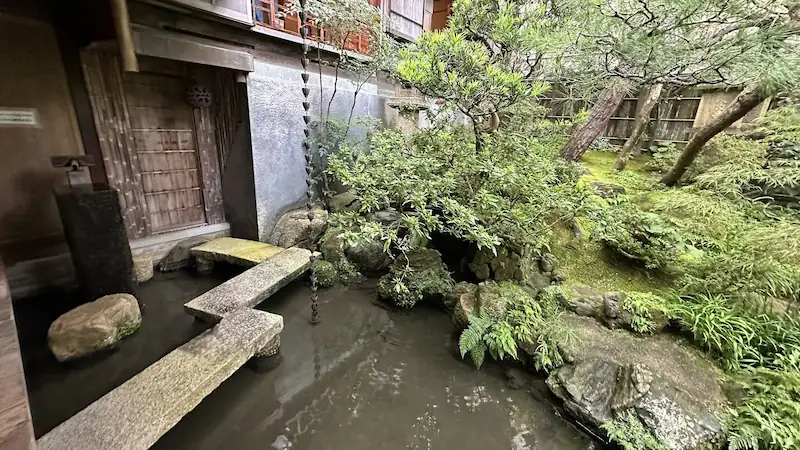
Overview
Set within Kanazawa’s beautifully preserved castle-town quarter, the Nomura Samurai Residence traces its origins to Nomura Denbē Nobusada, a retainer of the Kaga Domain. For eleven generations the family held magistrate posts, and the property—its garden, shoin-style rooms, earthen walls, and stone-paved lanes—still conveys the refinement of samurai life. Expect 400-year-old trees, a pond garden with meandering stream, armor and swords, and elegant fusuma-e (sliding-door paintings)—together transporting you to the lifestyle of upper-ranking warriors. The garden has ranked as high as No. 3 in Japan by an international journal and earned two stars in the Michelin Green Guide Japan.
| Era of estate | Edo period for the original estate; current buildings incorporate a kitamaebune shipowner’s residence relocated and remodeled in the early Shōwa era (garden techniques/building elements carry Edo DNA) |
|---|---|
| Founder | Nomura Denbē Nobusada (Kaga retainer) |
| Features | Tea room with sukiya flavor, pond garden with winding stream, samurai townscape of walls and stone paths |
| Restorations | Following Meiji-era abolishment of the samurai system, parts were dismantled; in early Shōwa, a shipowner’s residence was relocated to form today’s house |
| Current State | Open to the public; residence and garden both viewable |
| Losses | Parts of the main residence were demolished in Meiji; the original plot was reduced |
| Cultural Status | Main building (former Nomura residence) is a Registered Tangible Cultural Property of Japan |
| Notes | Garden ranking: 2003 Journal of Japanese Gardening, No. 3 nationwide |
🗺 Address: 1-3-32 Nagamachi, Kanazawa, Ishikawa
🚶 Access
About 2 minutes on foot (220 m) from the Nagamachi Samurai District
⏳ Time Needed
Quick look: about 30–40 minutes
Leisurely visit: about 1–1.5 hours
🌎 Official Website
📍 Highlights
- Garden (stream, stone bridges, ancient trees): The meandering stream runs to the engawa; a 400-year-old tree and a striking yukimi lantern crown the view.
- State room, fusuma-e, arms & armor: A high-status “upper room” with paintings by the lord’s official artist; arms/armor evoke the household’s rank.
- Seasonal scenes: Snow hanging and straw wall covers in winter; cherry blossoms, lush green, and vivid autumn foliage—photogenic year-round.
📌 Trivia
- A reduced remnant: The original plot measured about 3,300 m²; after Meiji reforms, much was sold off—what you see is a precious fragment.
- Hidden gem: The tea room “Fubaku-an” uses a single slab of ancient sugi in its ceiling—exceptionally lavish for a tea space.
- Famous connections: The first-generation Nomura served the famed warlord Maeda Toshiie and held senior rank in Kaga.
Sendake Garden
⭐ Recommendation
Historical Value: ☆☆
Visual Appeal: ☆☆☆
Experiential Value: ☆☆
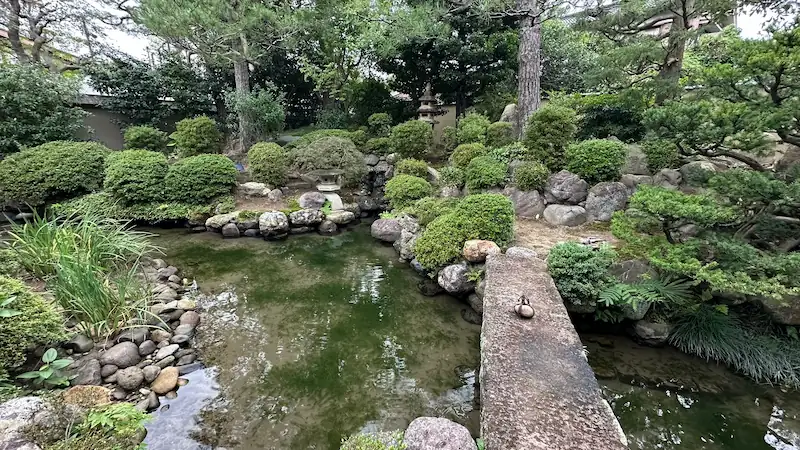
Overview
Located in the Nagamachi Samurai District, Sendake Garden is a pond-strolling garden created in 1894 by Senda Norifumi, a former Kaga retainer. Water is drawn from the nearby Ōno-shō canal into a central pond framed by an artificial hill, stone bridges, and lanterns. Snow-view lanterns and a bridge of Akadomuro stone echo motifs seen at Kenrokuen. Opened to the public in April 2025, this once-private garden now welcomes visitors with flowing water, samurai-town ambience, and seasonal color.
| Built | 1894 (Meiji 27) |
|---|---|
| Creator | Senda Norifumi (former Kaga retainer) |
| Features | Pond-strolling layout fed by canal water; hillocks, stone bridges, snow-view lanterns, azaleas |
| Later Works | Refined mainly between late Meiji and Taishō; form largely unchanged since |
| Current State | Intact and open to the public |
| Loss/Damage | No notable losses recorded |
| Status | Kanazawa City-designated Historic Site & Place of Scenic Beauty |
| Notes | Public since April 2025; with a small reference museum on site |
🗺 Address: 1-4-22 Nagamachi, Kanazawa, Ishikawa
🚶 Access
Right in front of the Nomura Samurai Residence
⏳ Time Needed
Quick visit: about 20–30 minutes
Unhurried: about 1 hour
🌎 Official Website
📍 Highlights
- Strolling path around pond & hill: Flowing water, stone bridges, and placed rocks create a quietly immersive circuit.
- Yukimi lantern & Akadomuro stone bridge: Design cues that echo Kanazawa’s grand garden tradition.
- Seasonal palette: Azaleas and satsuki in late spring, lush greens, autumn colors—and crisp winter air.
📌 Trivia
- Clever use of canal water: Early example in Nagamachi of integrating the Ōno-shō waterway directly into a private garden.
- Listen for water music: A suikinkutsu and shishi-odoshi add aural charm.
- Owner’s background: Senda Norifumi was a former Kaga retainer active through the turbulent late Edo–Meiji transition.
Kanazawa City Ashigaru Museum
⭐ Recommendation
Historical Value: ☆☆
Visual Appeal: ☆☆
Experiential Value: ☆☆☆
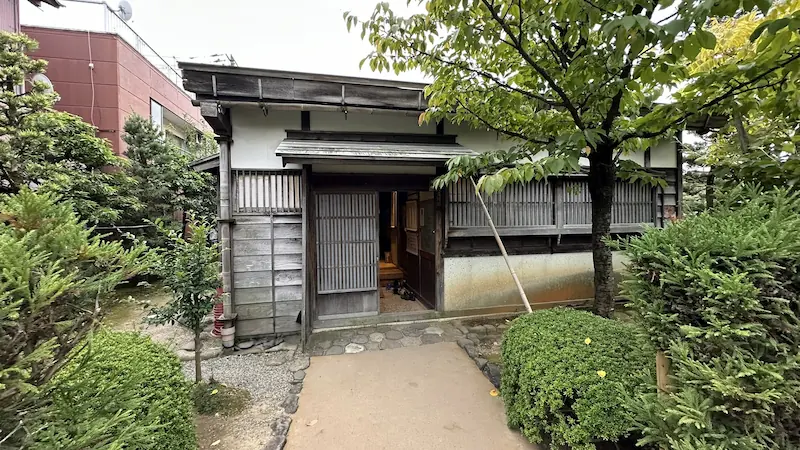
The Ashigaru Museum stands within the Nagamachi district and showcases the daily life of the Kaga Domain’s foot soldiers. Opened in November 1997, it consists of two relocated/reconstructed ashigaru houses—those of the Takanishi and Shimizu families. Interiors recreate living spaces (sitting room, kitchen, sleeping quarters) and present exhibits on jobs, income, and family life for lower-ranking samurai.
| Opened | November 1997 (Heisei 9) |
|---|---|
| Address | 1-9-3 Nagamachi, Kanazawa, Ishikawa |
| Hours | 9:30–17:00 (last entry 16:30) |
| Closed | Open daily (year-round) |
| Admission | Free |
| Features | Two single-story wooden ashigaru houses (Takanishi/Shimizu); stone-weighted board roofs; faithful room reconstructions |
| Exhibits | Daily utensils, tools, tray meals, panels on roles/income/family life |
| Notes | Convenient stop along the Nagamachi stroll; a municipal tourist parking lot is nearby |
🗺 Address: 1-9-3 Nagamachi, Kanazawa, Ishikawa
🚶 Access
About 3 minutes on foot (250 m) from Sendake Garden
⏳ Time Needed
Quick visit: about 15 minutes
Reading panels in detail: about 30 minutes
📍 Highlights
- Takanishi & Shimizu Houses: Two relocated ashigaru residences with stone-weighted board roofs; layouts faithfully reproduced.
- Everyday life exhibits: Household items, tools, tray meals—snapshots of daily routines.
- Clear explanatory panels: Duties, income/expense, and family structures—well-illustrated for context.
- Hedges & plantings: Garden elements around the houses recreate the period setting.
- Compare in context: Located within the broader Nagamachi route—contrast with upper-class residences nearby.
📌 Trivia
- Free admission: A community-oriented facility open to residents and travelers alike.
- Kaga’s ashigaru policy: Unlike many domains that housed ashigaru in barracks, Kaga often provided detached homes—reflected in these layouts.
- Detailed labeling: Despite being free, the exhibits are notably thorough and informative.
- Preservation initiative: Opened in 1997 as part of a broader effort to safeguard Nagamachi’s samurai heritage.
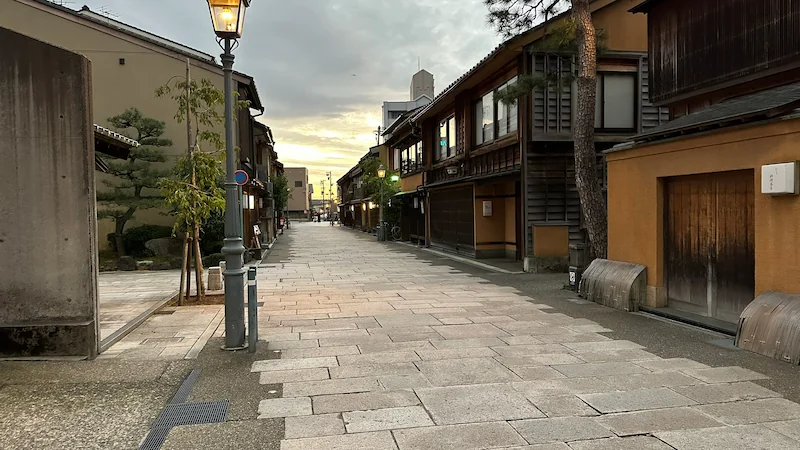



comment